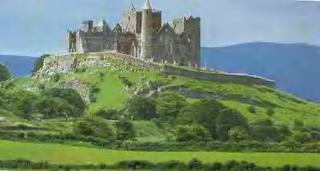The Kings of Ireland

The Hill of Tara, known as Temair in gaeilge, was once the ancient seat of power in Ireland – 142 kings are said to have reigned there in prehistoric and historic times. In ancient Irish religion and mythology Temair was the sacred place of dwelling for the gods, and was the entrance to the otherworld. Saint Patrick is said to have come to Tara to confront the ancient religion of the pagans at its most powerful site.
One interpretation of the name Tara says that it means a "place of great prospect" and indeed on a clear day it is claimed that features in half the counties of Ireland can be seen from atop Tara. In the distance to the northwest can be seen the brilliant white quartz front of Newgrange and further north lies the Hill of Slane, where according to legend St. Patrick lit his Pascal fire prior to his visit to Tara in 433 AD.
Early in the 20th century a group of Israelites came to Tara with the conviction that the Arc of the Covenant was buried in on the famous hill. They dug the Mound of the Synods in search of the Arc but found only some Roman coins. Official excavation in the 1950s revealed circles of post holes, indicating the construction of substantial buildings here. A new theory suggests Tara was the ancient capital of the lost kingdom of Atlantis. The mythical land of Atlantis was Ireland, according to a new book.
There are a large number of monuments and earthen structures on the Hill of Tara. The earliest settlement at the site was in the Neolithic, and the Mound of the Hostages was constructed in or around 2500BC. There are over thirty monuments which are visible, and probably as many again which have no visible remains on the surface but which have been detected using special non-intrusive archaeological techniques and aerial photography. A huge temple measuring 170 metres and made of over 300 wooden posts, was discovered recently at Tara. Only two monuments at Tara have been excavated - The Mound of the Hostages in the 1950s, and the Rath of the Synods at the turn of the 19th-20th Centuries



0 Comments:
Post a Comment
<< Home